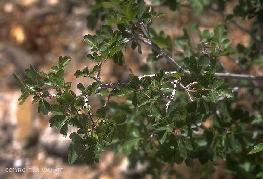

Squawbush
Rhus trilobataNutt.
Squawbush is a shrub from 4 to 8 feet tall and spread. Can become yearly shearing to the ground results in a tighter plant with long, attractive stems. The leaflets are usually divided in threes, occasionally only one to a leaf, with each being about 3/8 to 1 1/2 inch long. New leaves emerge with a beautiful scarlet coloration, and are rather shiny in appearance. The flowers are not very conspicuous, having yellow petals about 1/8 inch long. The fruit is a dry berry about 1/4 inch long, red or orange red in color covered with hairs. Turns deep reddish purple in autumn. Squawbush has a characteristic strong scent which some find displeasing, and that others can tolerate. It is found in on dry slopes, hills, canyons, valleys, and plains. It is found throughout the intermountain west at elevations from 3,500 to 9,000 feet.
Food Uses:
The berries, both green and
red, uncooked and cooked, were commonly used by Indians. The whole fruits could
be dried and stored for the winter. The ground-up berries were made into cakes
and dried in the sun for use in the future. The juice from the fruit can
be made into a lemonade-like drink. The berries could also be ground,
seeds and all, and made into a pudding. The berries often survive until
winter and can be one an excellent food source.
Planting:
Can be sown from seed or
taken from softwood cuttings. To start outdoors soak seed as above and place in
the desired location and cover with ¼" of soil. Sow in the fall.
